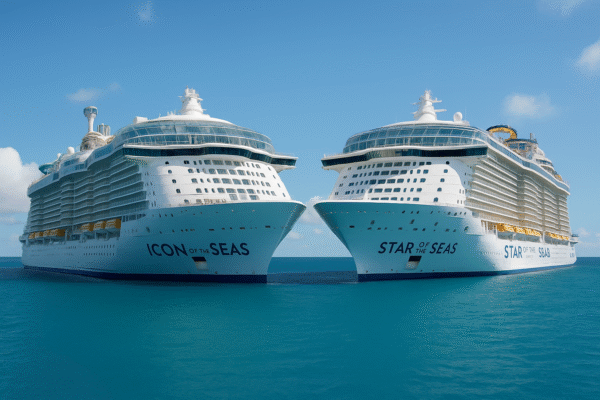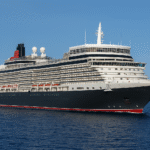The global cruise industry is witnessing a transformative moment as Royal Caribbean International expands its Icon Class fleet. The company, already known for introducing the world’s largest cruise ship, the Icon of the Seas, is building on its success with three additional vessels. These colossal ships, each more than 1,000 feet long and capable of hosting over 5,600 passengers, are redefining what it means to travel by sea.
With their home base at PortMiami in Florida and regular voyages to The Bahamas—including stops at Royal Caribbean’s exclusive private island, Perfect Day at CocoCay—these ships embody the concept of tourism where the vessel itself is as thrilling as the destination. The ongoing construction at Finland’s Meyer Turku shipyard reflects the international scale of this expansion, demonstrating the collaboration between global shipbuilding expertise and rising tourism demand.
A Historic Meeting in The Bahamas
In August 2025, the cruise industry marked a milestone when the Icon of the Seas and the Star of the Seas met for the first time at CocoCay. This historic event symbolized the doubling of Royal Caribbean’s capacity for its groundbreaking Icon Class. Passengers on the island witnessed the rare sight of two mega-ships docked side by side, a visual testament to Royal Caribbean’s ambition and influence.
The gathering of these giants was more than symbolic; it underscored the demand for immersive cruise vacations that combine innovation, entertainment, and luxury.
Expansion of the Icon Class Fleet
Following the success of the Icon of the Seas, Royal Caribbean launched the Star of the Seas in August 2025, offering routes through both the Eastern and Western Caribbean. The third ship in the series, the Legend of the Seas, is scheduled for its debut in August 2026. It will feature the largest waterpark at sea, Category 6, cementing the Icon Class reputation for blending adrenaline-pumping attractions with luxury.
Construction has also begun on the fourth Icon Class vessel at the Meyer Turku shipyard. Officially started in September 2025 with a keel-laying ceremony, the yet-to-be-named ship is set to join the fleet in 2027. With each vessel pushing the boundaries of design and capacity, the Icon Class is quickly becoming synonymous with the future of ocean travel.
Icon of the Seas: A Floating City
The Icon of the Seas has already become a modern marvel in maritime history. Sailing from Miami, it carries more than 5,600 passengers across the Caribbean. Onboard, guests find themselves in what feels like a floating city, complete with themed neighborhoods, fine dining, world-class entertainment, and adventure attractions.
Amenities include multiple pools, record-breaking waterslides, cutting-edge theaters, and family-focused experiences, making the ship itself a destination. This approach reflects the shift in cruise tourism where the vessel’s onboard offerings are as important as the ports of call.
Global Growth of Cruise Tourism
The cruise industry continues to grow rapidly. Industry projections indicate that more than 37 million passengers will embark on cruises in 2025, highlighting the increasing appeal of this form of travel. Royal Caribbean, alongside its competitors, is responding to this demand with larger and more technologically advanced vessels designed to deliver luxury, variety, and excitement.
The trend demonstrates a global shift in tourism preferences. Passengers are increasingly drawn to the convenience of a holiday where accommodation, entertainment, and transportation merge seamlessly in one immersive experience.
Competitors Embrace the Race for Size
Royal Caribbean is not alone in pursuing mega-ship dominance. Norwegian Cruise Line launched the Norwegian Aqua in April 2025, with room for 3,600 guests, and is planning a new fleet of larger ships beginning in 2030. MSC Cruises unveiled the MSC World America, a 6,762-passenger vessel that set sail in April 2025 from its new Miami terminal—the largest cruise terminal in North America.
Carnival Cruise Line has announced plans for an ambitious new class of ships capable of hosting nearly 8,000 passengers by 2029, demonstrating how the entire industry is moving toward ever-larger vessels.
Cruise Ships as Floating Resorts
The new Icon Class ships, like their competitors, showcase how cruise liners have evolved into floating resorts. Each ship offers not just transport, but entertainment complexes, wellness zones, shopping districts, and themed attractions. Travelers no longer view cruises as just journeys between destinations—they see them as complete tourism experiences at sea.
In addition to luxury, sustainability and technology play a crucial role. Modern ships are being designed with energy-efficient systems, advanced waste management, and environmentally friendly fuels, ensuring the growth of cruise tourism aligns with global sustainability goals.
Shipbuilding Excellence in Finland
The construction of the Icon Class vessels at the Meyer Turku shipyard in Finland highlights the global scale of cruise tourism. As one of Europe’s most advanced shipyards, it has been instrumental in bringing Royal Caribbean’s vision to life. The collaboration between American tourism demand, Bahamian destinations, and European shipbuilding expertise illustrates the interconnected nature of the industry.
The Future of Global Tourism at Sea
Royal Caribbean’s expansion of the Icon Class marks more than just the growth of a fleet—it signals the future of global cruise tourism. As ships become larger, more advanced, and increasingly self-contained, they will continue to attract millions of travelers seeking immersive experiences.
From Miami to The Bahamas and beyond, the Icon Class fleet represents the pinnacle of modern cruising: innovative, luxurious, and unforgettable. With passenger numbers climbing and shipbuilding accelerating, the age of the mega cruise ship is here to stay.
For more travel news like this, keep reading Global Travel Wire
















